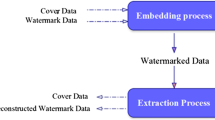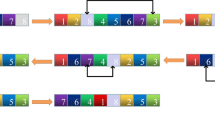Abstract
With the prodigious headway of the Internet of Things (IoT), cloud computing, Artificial Intelligence (AI), and big data, smart healthcare is expected to provide potential and competent healthcare services. Smart healthcare is changing the traditional healthcare system by making it more convenient, more expedient, more effective, and more personalized. The rampant health sector data breaches worldwide, however, testify to the need of ensuring the integrity and authenticity of data shared over insecure networks. In this paper, a secure self-embedding fragile watermarking scheme capable of authenticating the medical images and precisely localizing the tampered regions is presented. Two watermarks generated from the cover image called authentication watermark and localization watermark, are used for authentication and localization of the tampered region at the receiver. For watermark generation, the cover image is divided into 4 × 4 non-overlapping blocks. Each block is permuted using chaotic encryption before the watermark generation. The authentication watermark is a function of the 4-Most Significant Bits (MSBs) of each pixel of a block. Deoxyribonucleic Acid (DNA) encoding is used to ensure the security of the authentication watermark before its embedding. The localization watermark utilizes the arithmetic mean of a selected block and the Maximum Pixel Intensity (MPI) in that block. The DNA arithmetic is applied to generate the final authentication of watermark data. The tamper detection and localization results obtained for the proposed work are found to perform better compared to the state-of-art techniques. The proposed algorithm maintains better visual quality despite higher embedding capacity as indicated by an average Peak Signal to Noise (PSNR) value of 51.94 dB for an embedding capacity of 262,144 bits. The average value for the Structural Similarity Index Metric (SSIM) for the proposed scheme is found to be 0.9962 which is higher when compared to the techniques under comparison. The average False Positive Rate (FPR) for the proposed algorithm is found to be 3.9916 for tampering rates varied from 5 to 50%. The scheme outperforms the various state-of-the-art techniques making it an efficient candidate for tamper detection and localization in smart health applications.





















Similar content being viewed by others
References
Ansari IA, Pant M, Ahn CW (2015) SVD based fragile watermarking scheme for tamper localization and self-recovery. Int J Mach Learn Cybern 7(6):1225–1239
Anwer AA (2015) Exploiting similarities between secret and cover images for improved embedding efficiency and security in digital steganography. Doctoral thesis, University of Buckingham
Atawneh S, Almomani A, Al Bazar H et al (2017) Secure and imperceptible digital image steganographic algorithm based on diamond encoding in DWT domain. Multimed Tools Appl 76:18451–18472. https://doi.org/10.1007/s11042-016-3930-0
Azeroual A, Afdel K (2017) Real-time image tamper localisation based on fragile watermarking and Faber-Schauder wavelet. Int J Commun (AEÜ) 79:207–218
Barani MJ, Valandar MY, Ayubi P (2019) A new digital image tamper detection algorithm based on integer wavelet transform and secured by encrypted authentication sequence with 3D quantum map. Optik 187:205–222
Bhalerao S, Ansari IA, Kumar AA (2020) Secure image watermarking for tamper detection and localization. J Ambient Intell Humaniz Comput 12:1057–1068. https://doi.org/10.1007/s12652-020-02135-3
Cao F, An B, Wang J, Ye D, Wang H (2017) Hierarchical recovery for tampered images based on watermark self-embedding. Displays 46:52–60
Dorgham O, Al-Rahamneh B, Almomani A, Al-Hadidi M, Khatatneh KF (2018) Enhancing the security of exchanging and storing DICOM medical images on the cloud. Int J Cloud Appl Comput (IJCAC) 8(1):154–172. https://doi.org/10.4018/IJCAC.2018010108
Fan M, Wang H (2018) An enhanced fragile watermarking scheme to digital image protection and self-recovery. Signal Process Image Commun 66:19–29. https://doi.org/10.1016/j.image.2018.04.003
Feng B, Li X, Jie Y, Guo C, Fu H (2020) A novel semi-fragile digital watermarking scheme for scrambled image authentication and restoration. Mob Netw Appl 25:82–94. https://doi.org/10.1007/s11036-018-1186-9
Gao Z, Li Y, Sun Y, Yang J, Xiong H, Zhang H, Liu X, Wu W, Liang D, Li S (2018) Motion tracking of the carotid Artery Wall from ultrasound image sequences: a nonlinear state-space approach. IEEE Trans Med Imaging 37(1):273–283. https://doi.org/10.1109/TMI.2017.2746879
Goléa NEH, Melkemi KE (2019) ROI-based fragile watermarking for medical image tamper detection. Int J High Perform Comput Netwo 13(2):199. https://doi.org/10.1504/IJHPCN.2019.097508
Gull S, Loan NA, Parah SA (2018) An efficient watermarking technique for tamper detection and localization of medical images. J Ambient Intell Humaniz Comput 2018:1799–1808. https://doi.org/10.1007/s12652-018-1158-8
Haghighi B, Taherinia AH, Harati A (2018) TRLH: fragile and blind dual watermarking for image tamper detection and self-recovery based on lifting wavelet transform and halftoning technique. J Vis Commun Image Represent 50:49–64. https://doi.org/10.1016/j.jvcir.2017.09.017
Haider M, Tayeb L, Maria M, Damien M (2018) A survey on health monitoring systems for health smart homes. Int J Ind Ergon 66:26–56. https://doi.org/10.1016/j.ergon.2018.02.002
Hurrah NN, Parah SA, Sheikh JA (2020) Embedding in medical images: an efficient scheme for authentication and tamper localization. Multimed Tools Appl 79:21441–21470. https://doi.org/10.1007/s11042-020-08988-2
Kaur Y, Ranade SK (2017) Image authentication and tamper detection using fragile watermarking in spatial domain. Int J Adv Res Comput Eng Technol (IJARCET) 6(7):1058–1063
Liu X, Lin C, Yuan S (2018) Blind dual watermarking for color images’ authentication and copyright protection. IEEE Trans Circ Syst Video Technol 28(5):1047–1055
Liu Y, You Z, Gao T (2020) Lossless image hierarchical recovery based on POB number system. Signal Process 167:107293. https://doi.org/10.1016/j.sigpro.2019.107293
Nazari M, Sharif S (2017) An improved method for digital image fragile watermarking based on chaotic maps. Multimed Tools Appl 76(15):16107–16123
Prasad S, Pal AK (2020) A tamper detection suitable fragile watermarking scheme based on novel payload embedding strategy. Multimed Tools Appl 79:1673–1705. https://doi.org/10.1007/s11042-019-08144-5
Qi X, Xin X (2015) A singular-value-based semi-fragile watermarking scheme for image content authentication with tamper localization. J Vis Commun Image Represent 30:312–327
Qin C, Wang H, Zhang X, Sun X (2016) Self-embedding fragile watermarking based on reference-data interleaving and adaptive selection of embedding mode. Inf Sci 373:233–250
Qin C, Ji P, Wang J, Chang CC (2017) Fragile image watermarking scheme based on vq index sharing and self-embedding. Multimed Tools Appl 76(2):2267–2287
Qin C, Ping J, Zhang X, Jing D, Wang J (2017) Fragile image watermarking with pixel-wise recovery based on overlapping embedding strategy. Signal Process 138:280–293
Saeed S, Mohammad AA (2015) A source-channel coding approach to digital image protection and self-recovery. IEEE Trans Image Process 24(7):2266–2277
Sarkar D, Palit S, Som S, Dey KN (2020) Large scale image tamper detection and restoration. Multimed Tools Appl 79:17761–17791. https://doi.org/10.1007/s11042-020-08669-0
Shehab A, Elhoseny M, Muhammad K, Sangaiah AK, Yang P, Huang H, Hou G (2018) Secure and robust fragile watermarking scheme for medical images. IEEE Access 6:10269–10278
Shuo T, Wenbo Y, Jehane MLG, Peng W, Wei H, Zhewei Y (2019) Smart healthcare: making medical care more intelligent. Glob Health J 3(3)
Singh D, Singh SK (2015) DCT based efficient fragile watermarking scheme for image authentication and restoration. Multimed Tools Appl 76(1):1–25
Sivasubramanian N, Konganathan G (2020) A novel semi fragile watermarking technique for tamper detection and recovery using IWT and DCT. Computing 102:1365–1384. https://doi.org/10.1007/s00607-020-00797-7
Swaraja K, Meenakshi K, Kora P (2020) An optimized blind dual medical image watermarking framework for tamper localization and content authentication in secured telemedicine. Biomed Signal Process Control 55:101665. https://doi.org/10.1016/j.bspc.2019.101665
Tai WL, Liao ZJ (2018) Image self-recovery with watermark self-embedding. Signal Process Image Commun 65:11–25
Tiwari A, Sharma M, Tamrakar RK (2017) Watermarking based image authentication and tamper detection algorithm using vector quantization approach. AEU-Int J Electron Commun 78:114–123
Tong X, Liu Y, Zhang M, Chen Y (2013) A novel chaos-based fragile watermarking for image tampering detection and self-recovery. Signal Process Image Commun 28(2):301–308
Trivedy S, Pal AK (2017) A logistic map-based fragile watermarking scheme of digital images with tamper detection. Iran J Sci Technol Trans Electr Eng 41:103–113. https://doi.org/10.1007/s40998-017-0021-9
Wang L, Li L, Li J, Li J, Gupta BB, Liu X (2019) Compressive sensing of medical images with confidentially Homomorphic aggregations. IEEE Internet Things J 6(2):1402–1409. https://doi.org/10.1109/JIOT.2018.2844727
Watson JD et al (1953) Molecular structure of nucleic acids. Nature 171(4356):737–738
Xiang Y, Xiao D, Wang H, Li X (2019) A secure image tampering detection and self- recovery scheme using POB number system over cloud. Signal Process 162:282–295. https://doi.org/10.1016/j.sigpro.2019.04.022
Yu M, Wang J, Jiang G, Peng Z, Shao F, Luo T (2015) New fragile watermarking method for stereo image authentication with localization and recovery. AEU Int J Electron Commun 69(1):361–370. https://doi.org/10.1016/j.aeue.2014.10.006
Yung CS, Ming YW, Ya CY (2020) Discovering the potential opportunities of scientific advancement and technological innovation: a case study of smart health monitoring technology. Technol Forecast Soc Chang 160:120225. https://doi.org/10.1016/j.techfore.2020.120225
Zhang H, Wang C, Zhou X (2017) Fragile watermarking for image authentication using the characteristic of SVD. Algorithms 10(1):1–12
Zhang Y, Deng RH, Han G, Zheng D (2018) Secure smart health with privacy aware aggregate authentication and access control in internet of things. J Netw Comput Appl 123:89–100. https://doi.org/10.1016/j.jnca.2018.09.005
Acknowledgments
The authors would like to thank Department of Science and Technology (DST), Government of India for supporting this work under the DST Inspire Fellowship Scheme.
Author information
Authors and Affiliations
Corresponding author
Additional information
Publisher’s note
Springer Nature remains neutral with regard to jurisdictional claims in published maps and institutional affiliations.
Rights and permissions
About this article
Cite this article
Gull, S., Mansour, R.F., Aljehane, N.O. et al. A self-embedding technique for tamper detection and localization of medical images for smart-health. Multimed Tools Appl 80, 29939–29964 (2021). https://doi.org/10.1007/s11042-021-11170-x
Received:
Revised:
Accepted:
Published:
Issue Date:
DOI: https://doi.org/10.1007/s11042-021-11170-x




